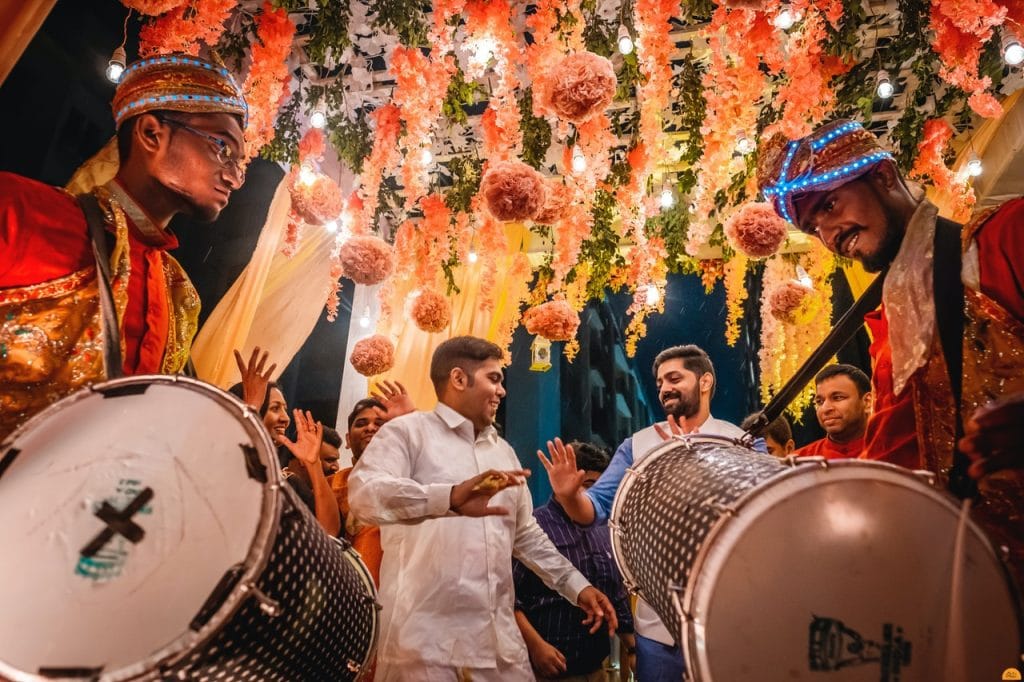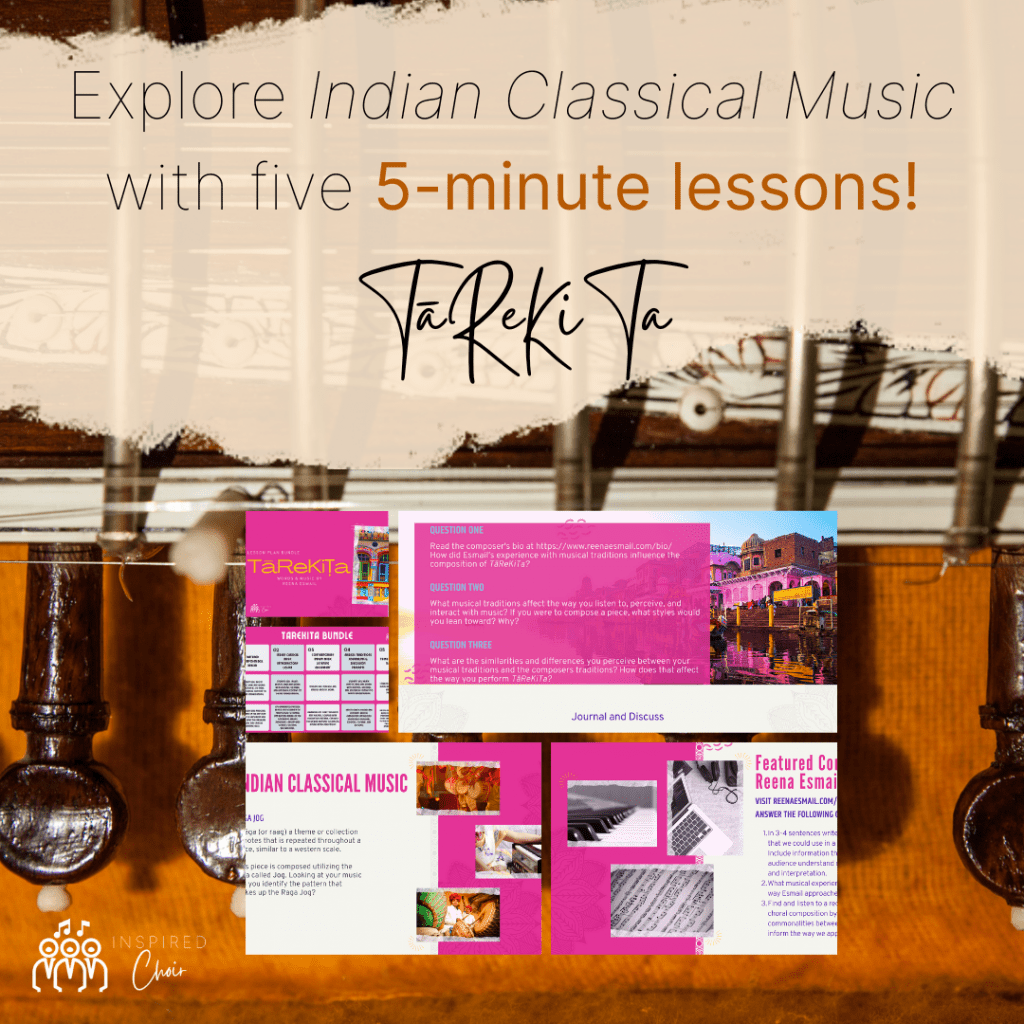Appreciating Indian Classical Frameworks with Reena Esmail’s TāReKiTa
Last year, one of my choral music education students introduced me to Reena Esmail’s work for choirs and I immediately added TāReKiTa to my to-program list. I could not pass up the driving rhythms, improvisatory sound, and gateway to a musical tradition that choral groups do not often study. Take a listen to the Los Angeles Master Chorale’s performance of the piece here. Below I discuss in depth the following aspects of TāReKiTa:
- Featured Composer: Reena Esmail
- Indian Classical Melodic Frameworks
- Contemporary Indian Music
- The Urban Voices Project
- Resources, Resources, Resources
- TāReKiTa Teacher Resources
- …and so much more!

Context is TāReKiTa’s Key
This fall, I will be working on TāReKiTa with two different ensembles: our treble ensemble at A-State and the Arkansas Choral Director’s Association Region One Junior High Tenor/Bass Ensemble. These are two very different ensembles who will learn and perform the piece in different ways. However, both groups will need to know and understand the musical context of this piece to produce an informed performance. Knowing about the composer, Indian classical melodic frameworks, and origins of the piece will help to do just that.
Featured Composer: Reena Esmail
Los Angeles based Reena Esmail composes in a style that is a wonderful fusion of Western and Indian classical musics. As a first-generation Indian American, Esmail found her musical style by searching for “places between my cultural identities that felt resonant to me.” (Read her article on finding resonant spaces through TāReKiTa here.)
The composer’s musical education has included time in both the Western classical world (with degrees from The Juilliard School and Yale School of Music) and the Hindustani musical world in India (with a Fulbright-Nehru study grant). Esmail has been commissioned to compose for choral groups across the United States, in addition to her work as an artist-in-residence.
Esmail has composed many works for choirs including:
- The Tipping Point for SATB Choir and Tabla with poetry by Amy Fogerson and Hindi and tabla bols
- I Rise: Women in Song for Treble Choir and string quintet, flute, and harp with texts from Emily Dickinson, Eleanor Roosevelt, Maya Angelou, and Arlene Geller
- Take What You Need for choir and community or audience voices
What is so cool about her compositions is that Esmail doesn’t stick to one style, ensemble-type, or mood. Each piece is unique and serves the particular ensemble and audience for which she intended the work. In addition to her choral works, Esmail has composed for orchestra, chamber ensembles, solo voice and instruments (Western and Hindustani), and youth ensembles of all kinds. View her full catalogue here.

Indian Classical Melodic Frameworks
Indian Classical music dates back 6,000 years to the system of musical notes and rhythmic cycles for sacred Vedic chants. Often taught orally, the study of Indian classical music is in-depth, rigorous, often spiritual, and uses improvisation liberally.
Rāga in TāReKiTa
A rāga (or raag) is a theme or collection of notes that is repeated throughout a piece, similar to a western scale. This piece is composed utilizing the rāga called Jog. In this piece, the notes of the rāga Jog are as pictured below.


Notice the differences between the scale on the way up and down. (Bonus points to anyone who can remember which Western minor scale is different on the way up and down!) As Esmail notes in her explanation of the piece on page 2 of the octavo, this rāga utilizes both major and minor tonalities. Throughout the piece, we hear the melody utilizing this raga with an improvisatory sound.
Rhythm in TāReKiTa
Did your elementary music teachers teach rhythm using ta’s and titi’s or takadimi’s or 1 and 2 and’s? These are all systems for learning Western classical rhythm structures. In India, many musicians learn using rhythm using Konnakol, spoken rhythmic syllables that mimic the sounds of Indian Instruments.
Rather than saying “ti-ti-ti-ti-ti-ti” for three beats of eighth notes, someone using the konnakol system would say “Tha Ka Dhi Mi Tha Ka.” Recognize those syllables? Esmail utilizes these syllables and other onomatopoeic (words like “bang” or “neigh”) representations of percussion sounds throughout the piece.
Contemporary Indian Music
Many times as we learn choral music, we essentialize a culture to a singular musical tradition. Although Indian classical music is such an extensive and vibrant tradition, there is so much more Indian music out there! Here are a few genres to help broaden our idea of music from India:
- Indi-pop: Not to be confused with the calm, folksy indie-pop, Indian pop music is a large part of Indian art and culture. Including pop bands, metal bands, rappers, and solo singers the popular music industry is strong in India. This Indian Pop Hits playlist is full of bops including songs from Vande Mataram, Rang De Basanti, and Phir Bhi Dil Hai Hindustani.
- Bollywood: Hindi cinema is a huuuuge industry in India, producing more than 1,000 films per year. Bollywood (Bombay + Hollywood = Bollywood) films include much dancing and singing about love, friendship, and devotion. Modern films incorporate both Western and Indian instruments, and it is not uncommon to hear string orchestras combined with sitars and tablas in a Bollywood song. Check out the top Bollywood Songs of 2022 here.
- Bangladeshi Rock: Derived from American and British music and influenced by Bengali classical and folk music, Bangla Rock was born in the 1960s. Like rock from around the world, Bangladeshi Rock has evolved to include a variety of sounds like glam-rock, post-punk, grunge, and metal. Listen to The Sound of Bangladeshi Rock for a good variety of Bangla Rock music.

The Urban Voices Project and TāReKiTa
Composer Reena Esmail wrote TāReKiTa for the choir of The Urban Voices Project, a community that uplifts the residents of Downtown Los Angeles’s Skid Row through music and wellness programming.
According to Esmail, the piece came about as an improvisation with the Urban Voices Choir as she was teaching them about Indian rhythm. She taught the group the foundation by rote and vocally improvised over the ensemble. When Esmail came back the next rehearsal and the singers wanted to know and sing more, she realized she needed to formalize the piece that would become TāReKiTa for them.
The Urban Voices Project programs include neighborhood and family sings, music education and wellness classes, and the performance ensemble. To support the project, visit this link.
So Many Resources!
In order to perform this piece in a fully informed manner, there are so many resources that we can utilize – many of them coming from the composer herself. Here are a few of my must-use resources when studying this piece:
- TāReKiTa’s origin story as told by composer Reena Esmail.
- Esmail’s playlist of three audio guides for pronunciation of the text.
- Mudra tutorial by Bharatanatyam choreographer Shalini Haupt
- Blog post by the composer about TāReKiTa
- Introduction to Solkattu by Embodying Rhythm
- This post by the Met Museum about Musical Instruments of India
I’ll be sure to add more resources to this list as I come across them this semester.
Complimentary Pieces
Want to listen to other pieces like TāReKiTa? Or planning a concert and need some programming ideas? Here are a few complementary pieces!
Choral Music Inspired by Indian Classical Frameworks:
- Like in TāReKiTa, in Desh as arranged by Ethan Sperry, singers are asked to reproduce the sound of traditional Indian instrumental ensembles. Great challenge for SATB and TTBB ensembles.
- Raagi Thandheera arranged Sheena Phillips & Smitha Vishveshwara presents an opportunity for SSAA ensembles to explore music of southwest India. Rhythmic and alliterative, the lyrics are in the Kannada language and speaks of giving alms.
- Available in SAB and two-part, Aeyaya Balano Sakkad with words by Smt. Chandra Bhat, music by M.B. Srinivasan, and arranged by John Higgins and Dean Crocker would be a nice introduction to classically-influenced choral music for developing singers. Especially if you had someone who could play sitar and tabla for your ensemble.
A few of the other “roots” themed pieces I’m pairing with TāReKiTa this concert cycle:
- Ysaye M. Barnwell’sWanting Memories
- Hart Rouge’s Vichten
- Susan Labarr’s The River
- Miriam Sonstenes’s I Am Leaving
- The full “Singing Our Roots” program round-up
- The full “Ascend” program round-up

I’d Love to Hear from You!
Have you sung or conducted TāReKiTa with your choir? How did your ensemble handle the driving rhythms and improvisation-like nature of the piece? What connections were you able to make to traditional and contemporary Indian music? What must-have resources did you use to prepare this piece? Let me know in the comments section below!
Wanting Memories Teacher Resources
Free Comprehension Worksheets
Choir Leaders! I have begun to include short comprehension worksheets with each Inspired Choir blog post. Each worksheet includes 5-6 knowledge-based questions about the post and concludes with a musical decisions/applications question. Use as a homework assignment, sub activity, listening challenge, or guide for conversation in class. Fill in the form below to receive a link immediately to all “Roots” Worksheets.
TāReKiTa Lesson Plan Bundle
Check out the Inspired Choir Shop for the TāReKiTa Lesson Plan Bundle. This bundle includes the following five minute lesson plans, all with connections to National Standards and SEL Competencies:
- Featured Composer Bell Ringer
- Indian Classical Music Introductory Lesson
- Contemporary Indian Music Listening Assignment
- Musical Traditions Journaling & Discussion Prompts
- Think Fast! Rhythm Flashcards



















WOW! I absolutely LOVE this! Thank you so much for this thorough deep dive into TaReKiTa, and creating this great resource for choirs!
This is absolutely phenomenal. Thank you for making this rich resource for choir directors & students!